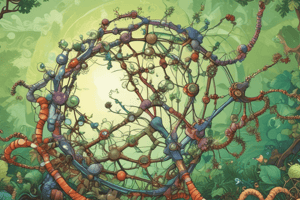Podcast
Questions and Answers
What is the main fuel source used in sprinting?
What is the main fuel source used in sprinting?
Muscle ATP
What is the enzyme that breaks starch into glucose?
What is the enzyme that breaks starch into glucose?
Amylase
What are the two main types of cells based on their structure?
What are the two main types of cells based on their structure?
Prokaryotes and Eukaryotes
What is the main function of internal membranes in eukaryotic cells?
What is the main function of internal membranes in eukaryotic cells?
What type of barrier keeps some fluids from entering and leaving the cell but allows for diffusion of O2 and CO2?
What type of barrier keeps some fluids from entering and leaving the cell but allows for diffusion of O2 and CO2?
What type of fats make the cell membrane runny?
What type of fats make the cell membrane runny?
What is the role of biochemistry and biomolecules in living organisms?
What is the role of biochemistry and biomolecules in living organisms?
How does life utilize energy?
How does life utilize energy?
Why is the expression and transmission of genetic information important for life?
Why is the expression and transmission of genetic information important for life?
What are the key components of a cell related to cell biology?
What are the key components of a cell related to cell biology?
Explain the concept of respiration in the context of cellular biology.
Explain the concept of respiration in the context of cellular biology.
How does growth and reproduction contribute to the survival of living organisms?
How does growth and reproduction contribute to the survival of living organisms?
What are the four types of biomolecules found inside cells?
What are the four types of biomolecules found inside cells?
Explain the concept of antibodies and their role in protecting cells.
Explain the concept of antibodies and their role in protecting cells.
What is the function of the Ace2 receptor in the human body?
What is the function of the Ace2 receptor in the human body?
Describe the process of inductive reasoning in scientific discovery.
Describe the process of inductive reasoning in scientific discovery.
Explain the significance of mutations in the spike protein of a virus.
Explain the significance of mutations in the spike protein of a virus.
What are the key characteristics of a drug that scientists aim for in drug development?
What are the key characteristics of a drug that scientists aim for in drug development?



